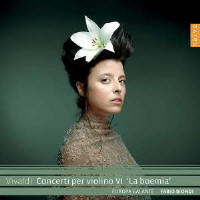Texte paru dans: / Appeared in:
|
|
|
Outil de traduction (Très approximatif) |
|
|
Reviewer: Robert Maxham Naïve has dedicated a volume (number 57 in its Vivaldi Edition) to concertos Vivaldi wrote, according to Fabio Biondi’s notes, for his stay in Bohemia in 1730–31. Biondi maintains that these concertos weren’t conceived as a corpus and, in fact, seem to come from different stylistic “phases.” He compares the recording’s first concerto, RV 282 in F Major, to the concerto written for the feast of San Lorenzo—it’s virtuosic in its outer movements, with hissing and spitting articulation, representing a style of which Biondi has become a past (but also, it seems, a present) master. The collection’s second concerto, in E Minor, represents a sort of study in sudden, stunning, contrasts—in tempo, texture, and Affekt—combining all this with a violinistic technique that in its boldness must at its time have seemed almost transcendentally brilliant. (The violin he plays, made by Andrea Borelli in Parma in 1735, strops an edge on this passagework.) Biondi describes the dramatic dotted rhythms accompanying the slow movement’s cantilena as homage to the French style, which, he suggests, Vivaldi knew very well. The finale features a viscerally thumping rhythmic accompaniment but also combines flashes of violinistic virtuosity with rich harmonic semi-sequential patterns. Biondi interprets the dotted rhythms that open the collection’s third concerto, RV 380, as an attempt to assimilate to a Neapolitan style to which he had then been striving to adapt. He connects this movement to the slow one, and that one to the finale, with cadenza-like bridges. In that finale, which he illuminates with sprightly virtuoso figuration, often in the higher registers, he emphasizes Vivaldi’s contrasts with dramatic pauses. The Concerto in C Major, RV 186, turns out to be one of the shortest of these concertos, lasting fewer than 10 minutes. Biondi suggests that its technical simplicity would have suited it for performance on oboe and notes in the concerto a mix of styles. Biondi also likens the Concerto, RV 288, to the concertos that would have suited the oboe; it’s replete with Corellian backward glances in the slow movement and a more strikingly virtuosic finale. The last concerto in the collection, in G Minor, RV 330, also belongs, according to Biondi, to the group of backward-looking concertos; but in this case the violin part seems thoroughgoingly virtuosic, employing the whole bag of violinistic tricks, opening in double-stops and continuing in later episodes with passagework assembled from various forms of double-stoppings punctuated with exuberant runs. As in so many other concertos by the composer, this movement frequently changes direction abruptly (Vivaldi had forged his own signature version of dramatic musical rhetoric). Biondi—and Europa Galante—speak this musical dialect seemingly as a native tongue: He seems to have impressed its lineaments on his musical expressivity. Speaking in this way of Biondi’s intimate relationship with Vivaldi’s musical style makes an urgent recommendation of this release a matter of course, but the music itself also works in the compilation’s favor. So here it is: an almost pro forma Urgent Recommendation.
|
|




